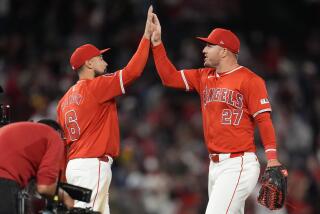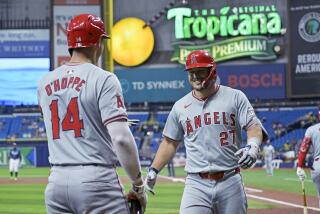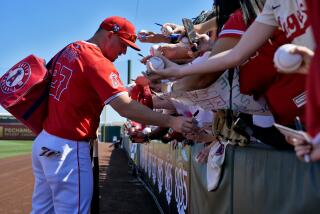Dodgers and Angels Back in Business
A ballplayer can hardly scratch or spit these days without someone attaching a statistic with a strange acronym to it. Those who grew up with ERA, HRs and RBIs are still coming to grips with a pitcher’s WHIP (walks plus hits divided by innings pitched), a fielder’s ZR (zone rating) and a batter’s OPS (on-base plus slugging percentage).
But as obscure as they seem, baseball’s new-age statistics can shed light on peculiarities that are difficult to quantify or explain, such as the Angel offense last season.
Ever wonder how a team with so little power and on-base ability squeezed enough out of its lineup to reach the American League championship series? The Elias Sports Bureau provides a clue.
According to Elias, the Angels led the league in 2005 with 187 “productive outs,” the number of times a team advanced a runner with zero outs or one out or drove in a run with one out. Angel veteran Darin Erstad was one of only 12 big leaguers with 25 or more productive outs.
“That statistic right there is what our offense is all about,” said Mickey Hatcher, Angel batting instructor. “That’s what we preach; that’s the way Mike [Scioscia] manages. We’re going to be aggressive. We hit and run a lot. A lot of guys give up at-bats to move runners. We’re not all about stats; we’re about winning. We call it Angels baseball.”
Proponents of the so-called “Moneyball” approach, which emphasizes on-base percentage and power, call it deficient. The free-swinging Angels ranked ninth in on-base percentage (.325), ninth in slugging (.409), 10th in home runs (147) and 10th in walks (447) last season.
But they also finished a respectable seventh in runs (761) because they hit for a solid average (.270, fifth in the league), hit a league-best .296 with runners in scoring position and led the league with 161 stolen bases.
They are a National League team in American League clothes, built around pitching and defense, speed and versatility, and if the Angels are to win a third straight division title -- they open the 2006 season Monday in Seattle -- they will have to execute almost flawlessly on offense, no matter how ugly the stat sheet.
Earl Weaver fancied the three-run home run. Know what illuminates these Angels’ halos? Going from first to third on a single and scoring on a groundout. Or walking, stealing second, taking third on a grounder to the right side and scoring on a sacrifice fly. Or starting a runner from first to stay out of a double play and having that runner score on a two-out hit.
The team’s unofficial mantra: Get ‘em on, get ‘em over, get ‘em in.
“You’re going to see on-base percentage drop when guys give themselves up for the team,” Erstad said. “Advance a guy from second, score him with a groundout -- on paper, it doesn’t look good, but we’re up, 1-0. We might not put up the big glitzy, showy stats, but we do what it takes to win.
“We’re an unselfish team, and that’s why we’ve won so many games. That, and obviously we have good pitching. We get a lead by manufacturing runs, hand the ball to our bullpen, hunker down behind them and play great defense.”
The Angels don’t have a choice. They were unable to add a slugger over the winter, and their 2006 lineup looks much like the 2005 version, which struggled for long stretches and was unable to provide consistent protection for its most potent hitter, right fielder Vladimir Guerrero.
So, to score enough runs to support what should be one of baseball’s best pitching staffs, the Angels will again have to scratch and claw for offense, run the bases aggressively, execute the situational hitting game and hit in the clutch.
They will need leadoff batter Chone Figgins and No. 2 hitter Orlando Cabrera to get on base in front of Guerrero and Garret Anderson. They will need Juan Rivera, Erstad, Casey Kotchman and Tim Salmon to drive in runs. They will need some kind of production from the bottom of the order.
“Every team needs situational hitting, but for us it’s crucial,” Scioscia said. “New York, Boston, Texas, they can absorb a little more non-execution because they have so much power. We don’t have as many mulligans in our lineup.... Like basketball, where you can’t have a fast break without a rebound, we can’t have good situational hitting without getting on base.”
To that end, the Angels would do well to draw more walks, but that’s simply not their nature. Guerrero and Anderson have been successful with their aggressive approaches, and they’re too far along in their careers to change now.
Of active players with 5,000 plate appearances in the last 10 seasons, only two -- Neifi Perez and Mark Grudzielanek -- have walked fewer times than Anderson. And it seems the only way to walk Guerrero, one of baseball’s best bad-ball hitters, is to do so intentionally. The addition of the selective Kotchman and Salmon could help, but Cabrera, Rivera, Erstad and No. 9 hitter Adam Kennedy don’t walk much.
“You can preach it all you want, but when you have guys who are successful veterans, it’s tough,” Hatcher said. “Guys like G.A. have a certain approach, and you have to let them play their game. Look at Vlad. I’m not going to tell him to go up there and walk. He’s not going to do it. It’s tough to change philosophies.”
Erstad knows.
“You can’t look for walks -- when I’ve tried that, I’m usually down 0-and-2 in the count,” Erstad said. “You can’t take an aggressive hitter’s aggressiveness away. We’ve never walked a lot. We took it to a different level last year. But if everyone hits how they’re supposed to, it doesn’t matter.
“Our whole thing is putting the ball in play, putting pressure on the defense. It’s fun, because the other team knows it’s coming and can’t do anything about it. The ‘Moneyball’ people are going to be critics, but like Mickey said, that’s Angels baseball. That’s what we do here.”*
*
Position breakdown
* INFIELD: The Angels, with shortstop Orlando Cabrera and second baseman Adam Kennedy, are as strong up the middle defensively as any team in baseball, and Casey Kotchman is a more-than-capable replacement for Darin Erstad at first. Chone Figgins has mixed spectacular plays with occasional errors on routine plays, but on the whole, he’s a proficient third baseman. Figgins is also the ignition to the offense, a speedy leadoff batter who led the major leagues with 62 stolen bases last season and ranked sixth in the American League with 113 runs. A more productive season from Cabrera, who bats second, would be a huge boost to the offense.
* OUTFIELD: Erstad, who won a Gold Glove in center field in 2002, returns to the outfield after two seasons at first, and Vladimir Guerrero, while occasionally taking some odd routes to balls, is a solid defender with one of the game’s best throwing arms. A foot injury could force left fielder Garret Anderson to spend more time at designated hitter, but his successor, Juan Rivera, has a stronger throwing arm. Guerrero, Rivera and Anderson will be relied upon to provide the bulk of the power. A bounce-back year from Erstad, who hit .273 with seven homers and 66 RBIs last season, would help.
* CATCHING: Though the Angels let two-time Gold Glove winner Bengie Molina go, they should be just as strong defensively with Jose Molina and rookie Jeff Mathis, who will share catching duties. Molina has extensive experience handling the Angels’ returning pitchers, he threw out 49% of base-stealers last season, best in the AL, and he has a wicked pick-off move to first. Mathis is an agile defender with a solid arm who looked good behind the plate this spring. But neither is expected to be much of a factor offensively. Molina will provide occasional power but makes inconsistent contact, and Mathis has only three big league at-bats.
* STARTING PITCHING: This is the Angels’ strength, with 2005 AL Cy Young Award winner Bartolo Colon (21-8, 3.48 ERA); John Lackey, who is brimming with confidence after a breakout 2005 (14-5, 3.44 ERA, 199 strikeouts); innings-eater and control specialist Jeff Weaver, who went 27-24 with a 4.11 ERA, 310 strikeouts and 110 walks for the Dodgers over the last two seasons; five-pitch wonder Kelvim Escobar, who is returning to the rotation after finishing an injury-marred 2005 as one of the Angels’ most effective relievers; and Ervin Santana, who dominated opponents at times with his 95-mph fastball and breaking ball as a rookie in 2005.
* BULLPEN: The Angels didn’t add any offense over the winter, but they did address two glaring needs -- bullpen depth and left-handed relief help. The addition of veteran right-hander Hector Carrasco and veteran left-hander J.C. Romero should ease the burden on heavily worked set-up man Scot Shields and help neutralize some of the league’s top left-handed hitters. If right-handers Brendan Donnelly and Esteban Yan continue to throw the ball as well as they have this spring, the Angels could have baseball’s best bullpen. Francisco Rodriguez, who tied for the AL lead with 45 saves in his first full season as the closer, also has looked sharp this spring.
* BENCH: The backup catcher spot -- either Molina or Mathis, depending on who is starting that day -- will be a strength. Maicer Izturis is a solid middle infielder, and with third baseman Edgardo Alfonzo available off the bench, Izturis shouldn’t have to play much at third, his worst defensive position. Alfonzo, who bats right-handed, also could spell Kennedy at second. Three players -- veteran Tim Salmon, who has missed 1 1/2 years because of shoulder and knee surgeries, utility player Robb Quinlan and third baseman Dallas McPherson -- are competing for the final two bench spots.
* MANAGEMENT: Manager Mike Scioscia’s primary challenge will be the same as it was in 2005, to get the most out of a lineup that has too many dead spots and too little power. He’ll also have to figure out how to use his new bullpen toy, a left-hander. General Manager Bill Stoneman has the chips to make an in-season deal to bolster the offense, but he has been reluctant to deal his top prospects.
-- MIKE DIGIOVANNA
More to Read
Go beyond the scoreboard
Get the latest on L.A.'s teams in the daily Sports Report newsletter.
You may occasionally receive promotional content from the Los Angeles Times.







